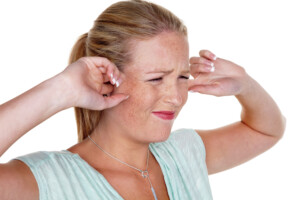
Anybody who’s health conscious will want to know the truth about hearing loss dangers from pounding music in group fitness classes.
Imagine you, the group fitness class enthusiast, are transported back in time about 60 years. Your mission is to spread the word that smoking damages the lungs.
Yeah, right. People will think you’re nuts. Cigarettes are offered to passengers on airplanes. Print ads for cigarettes say, “Just what the doctor ordered.” Ads for cigarettes are all over TV.
It took decades for the truth about smoking’s hazards to be taken seriously.
Unfortunately, this same denial continues to be playing out when it comes to the damage that thundering music in group fitness classes causes to hearing.
Attend enough fitness classes and you’ll get hearing loss.
“It is true that group fitness participants like their music loud to be motivated to move in their workouts,” says Rachel Raphael, M.A., CCC-A, an audiologist with ENT Baltimore. She’s also a certified group fitness instructor..
“The catchphrase of my popular Les Mills certifying agency (out of New Zealand) was ‘Turn It Up!’ which kind of makes me cringe knowing the potential danger in blasting our music.”
Vast Majority of Fitness Class Instructors in Denial about Hearing Loss Risk
“As an audiologist, I have an obligation to limit the output of the music, and not ‘turn it up,’ so that I don’t cause hearing loss in the participants,” says Raphael.
“I believe there is a happy medium where the music can be loud enough without being dangerously loud.”
The music in fitness classes is louder today than it was in the 1970s, even ‘80s. It seems to be getting louder and louder. The excessive amplification of the group fitness class leader’s microphone makes the issue even worse.
Raphael says that she jokes to her class she’d be happy to fit them with hearing aids “in the near future if they insist on louder music!”
Group Fitness Classes Are Not Night Clubs or Rock Concerts
The music volume, says Raphael, “should never be in the category of rock concert loud (approximately 120 decibels), or to where people experience tinnitus (ringing in the ears; phantom ear noises) or fullness in the ears following the exposure (a sign of temporary threshold shift), like is often reported after rock concerts.”
Good hearing just as important as good cholesterol, good bone health and good muscle tone!
“Typically, the rule of thumb is sounds of 85 dB (average factory) or louder are potentially damaging to the fragile hair cells of the inner ear cochlea (length of exposure and individual susceptibility also play a big role), and people should limit their duration and/or use hearing protection in their presence.”
Performing complicated or grueling moves in a fitness class will not protect even the fittest person from hearing loss when the music is thundering.
Unlike coronary heart disease, hearing loss is NOT reversible.

Rachel A. Raphael specializes in clinical audiology and hearing aid dispensing. She helps in the diagnosis of hearing loss, tinnitus, dizziness and vestibular pathology in adults and children.
 Lorra Garrick has been covering medical, fitness and cybersecurity topics for many years, having written thousands of articles for print magazines and websites, including as a ghostwriter. She’s also a former ACE-certified personal trainer.
Lorra Garrick has been covering medical, fitness and cybersecurity topics for many years, having written thousands of articles for print magazines and websites, including as a ghostwriter. She’s also a former ACE-certified personal trainer.
.
























